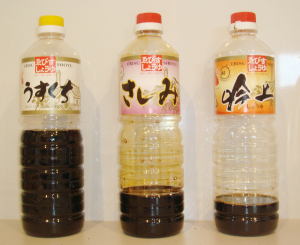Soy Sauce ― 2009/09/28

When you talk about soy sauce, the first thing you might think of would be Kikkoman. In this town that isn’t always true.
There are surprisingly large number of local soy sauce producers (I’d like to call them soy sauce breweries, if it is pragmatically OK) in Fukuoka. I had a quick look at Fukuoka Soysauce Industry Cooperative’s website and found that in Fukuoka metropolitan area, with population of 2.37 million, there are more than 20 small and medium-sized producers.
Soon after I began my life in the west of Fukuoka, I tried locally-produced soy sauces brewed by producers scattering within 10-kilometre radius from my place. What amazed me was how different the taste and flavour of soy sauce could be depending on producers.
As a whole, Fukuokan soy sauce tastes sweeter than Kikkoman’s or other major producers that you can find at supermarkets in other areas of Japan or of the world. If you have Tokyo taste, you should significantly reduce sugar or mirin when using made-in-Fukuoka soy sauce.
After a brief journey to find my favourite, I settled on a brand that my mother used, which I was very familiar with as a child but has forgot for a while. One's preference of soy sauces may be determined during childhood.
I usually use three kinds of soy sauces: Dark, Sashimi, and Light. Judging from the amount of soy sauce left in each bottle in the picture above, I seem to use much more dark soy sauce than the others.
 dark soy sauce
dark soy sauce
Dark soy sauce is probably what you call ‘soy source’, which can be used either heated or unheated.
 sashimi soy sauce
sashimi soy sauce
I use the Sashimi as a table sauce. Having thicker texture and stronger flavour than the dark soy sauce, very little amount of Sashimi sauce will enhance the taste and flavour of Sashimi, grated radish, rightly pickled vegetables, and so on. But, strangely, if you use this variety in warm dishes, it will lose its flavour and taste. I don’t know why, though.
 llight soy sauce
llight soy sauce
The light soy sauce is problematic.
It is supposed to be used when a recipe emphasizes the colour and flavour of the ingredients.
However, it is much saltier than dark one and difficult to decide how much I should use. In such cases, I tend to use dark soy sauce instead of the light one, excusing to myself “I’m not cooking a formal dinner, so as long as it’s palatable, I don’t have to care about the appearance of the plate”. As a result it will sit in the cupboard for longer than it’s ‘best-before’ date.
There are surprisingly large number of local soy sauce producers (I’d like to call them soy sauce breweries, if it is pragmatically OK) in Fukuoka. I had a quick look at Fukuoka Soysauce Industry Cooperative’s website and found that in Fukuoka metropolitan area, with population of 2.37 million, there are more than 20 small and medium-sized producers.
Soon after I began my life in the west of Fukuoka, I tried locally-produced soy sauces brewed by producers scattering within 10-kilometre radius from my place. What amazed me was how different the taste and flavour of soy sauce could be depending on producers.
As a whole, Fukuokan soy sauce tastes sweeter than Kikkoman’s or other major producers that you can find at supermarkets in other areas of Japan or of the world. If you have Tokyo taste, you should significantly reduce sugar or mirin when using made-in-Fukuoka soy sauce.
After a brief journey to find my favourite, I settled on a brand that my mother used, which I was very familiar with as a child but has forgot for a while. One's preference of soy sauces may be determined during childhood.
I usually use three kinds of soy sauces: Dark, Sashimi, and Light. Judging from the amount of soy sauce left in each bottle in the picture above, I seem to use much more dark soy sauce than the others.

Dark soy sauce is probably what you call ‘soy source’, which can be used either heated or unheated.

I use the Sashimi as a table sauce. Having thicker texture and stronger flavour than the dark soy sauce, very little amount of Sashimi sauce will enhance the taste and flavour of Sashimi, grated radish, rightly pickled vegetables, and so on. But, strangely, if you use this variety in warm dishes, it will lose its flavour and taste. I don’t know why, though.

The light soy sauce is problematic.
It is supposed to be used when a recipe emphasizes the colour and flavour of the ingredients.
However, it is much saltier than dark one and difficult to decide how much I should use. In such cases, I tend to use dark soy sauce instead of the light one, excusing to myself “I’m not cooking a formal dinner, so as long as it’s palatable, I don’t have to care about the appearance of the plate”. As a result it will sit in the cupboard for longer than it’s ‘best-before’ date.
最近のコメント